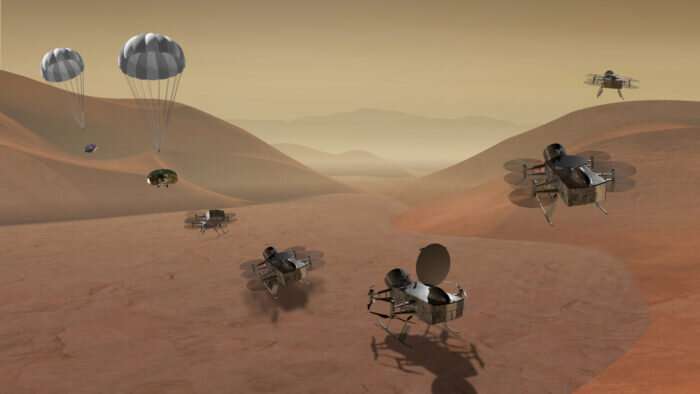
Catherine Neish is counting the days until her space launch. While the Western planetary geologist isn't space-suiting up for her own interstellar voyage, she is playing a key role in an international mission—dispatching a robotic drone to Saturn's moon Titan—set to blast-off in 2027.
For nearly two decades, the global space sector has focused a majority of its funds and research on Mars, in search of the building blocks of life. And yet, there are dynamic worlds like Saturn's moon Titan, which may actually have more going on biologically than the Red Planet.
In a recent study published by Astronomy and Astrophysics, Neish—a member of Western's Institute for Earth and Space Exploration (Western Space)—and her collaborators at the European Space Agency (ESA) used advanced imaging technology to investigate Titan. They found when impact craters are formed on Saturn's largest moon, it exposes relatively fresh 'water ice' from Titan's icy crust.
On Titan, atmospheric processes bury the ice under a layer of sand-like organic material. In Titan's dry equatorial regions, the sand piles up; but at higher, wetter latitudes, surface streams erode the sand away.
It is difficult to assess what lies beneath Titan's hazy atmosphere—unless of course, you have a multi-million dollar Visible and Infrared Mapping Spectrometer like ESA's, which collected both light visible to humans and infrared light of slightly longer wavelengths during NASA's Cassini mission.
"It's wild. There's no other place like Titan in the solar system. There's more sand on Titan per area than anywhere else," said Neish.
"Titan has weather. It's not unlike the Earth in that way. It's just that the ingredients are all wrong. It has methane rain and streams cutting through the surface and organic sand getting blown around. It's still very active, just like it is here on Earth," said Neish.
These findings could prove beneficial in discovering ancient ecosystems frozen in the bottoms of impact craters and will also prove invaluable when preparing data analysis and monitoring techniques for the forthcoming Dragonfly drone mission to Titan.
As interest in Titan and other planetary bodies grow, Neish feels the global space sector is ready to start looking beyond Mars for the existence of life—even if the Red Planet remains the prime destination for NASA, the Canadian Space Agency and blockbuster movie producers in Hollywood.
"I think more and more, we're seeing a false equivalency between life and Mars. The recent findings about Venus and all the new things we're learning about it once being an ocean world is another game-changer," said Neish. "Finally, people are saying, 'In our search for life in the universe, we really need to focus on a lot more places, and not just Mars.' And that includes NASA sending the Dragonfly mission to Titan."
Explore further
Citation: Recipe is different but Saturn's moon Titan has ingredients for life (2020, October 1) retrieved 1 October 2020 from https://phys.org/news/2020-10-recipe-saturn-moon-titan-ingredients.html
This document is subject to copyright. Apart from any fair dealing for the purpose of private study or research, no part may be reproduced without the written permission. The content is provided for information purposes only.
https://news.google.com/__i/rss/rd/articles/CBMiR2h0dHBzOi8vcGh5cy5vcmcvbmV3cy8yMDIwLTEwLXJlY2lwZS1zYXR1cm4tbW9vbi10aXRhbi1pbmdyZWRpZW50cy5odG1s0gFGaHR0cHM6Ly9waHlzLm9yZy9uZXdzLzIwMjAtMTAtcmVjaXBlLXNhdHVybi1tb29uLXRpdGFuLWluZ3JlZGllbnRzLmFtcA?oc=5
2020-10-01 19:30:50Z
52781096809081
Tidak ada komentar:
Posting Komentar